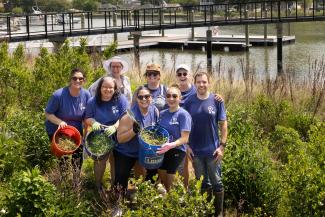
Weeding, Planting, and Protecting: A One-of-a-Kind Experience on the Elizabeth River
At Ideas by Mike, we believe in using our time and talents to make a positive impact in the community—especially when it comes to protecting the environment we all share. That’s why we recently joined forces with the Elizabeth River Project’s Ryan Resilience Lab, a local hub for environmental innovation and education, to support their ongoing efforts to restore and protect the native shoreline. We also teamed up with Chris Beach from EcoGardens 757, a gardening and landscaping business dedicated to nurturing local ecology, to support this vital work.
Our team spent the day maintaining the shoreline buffer, a critical zone of native vegetation that plays a key role in stabilizing the land, filtering runoff, and supporting local wildlife. This buffer is essential to the health of the living shoreline—a natural alternative to hardened seawalls that uses native plants and natural materials to prevent erosion and foster biodiversity.
More than just hands-on labor, the experience was a valuable learning opportunity. With guidance from the Resilience Lab team, we gained insight into the local plant species that form the backbone of this ecosystem, learned how to identify and remove invasive plants that threaten the area, and discovered simple but powerful ways individuals and businesses can help cultivate a healthier environment.
It was inspiring to see how much impact a group can make when aligned with a clear mission and strong local leadership. The work reinforced our belief that environmental resilience starts with community action—and every effort counts.
One of the key tasks during our visit to the Ryan Resilience Lab was the removal of vetch, an aggressive invasive plant that threatens to outcompete native vegetation. While vetch can improve soil in certain contexts, in this sensitive shoreline ecosystem it spreads rapidly and disrupts the natural balance. Working alongside environmental experts, we carefully removed vetch to make space for native plants to thrive.
In addition to weeding, we also had the unique opportunity to introduce black swallowtail caterpillars, affectionately known as “black parsley worms,” into the restored landscape. These native caterpillars play a critical role in the life cycle of the black swallowtail butterfly, a pollinator that depends on host plants like parsley, dill, and fennel. By creating a welcoming environment for these caterpillars, we’re not just encouraging biodiversity—we’re actively helping to rebuild pollinator populations that support the health of the entire ecosystem.
It was a powerful reminder that small actions—like pulling a weed or placing a tiny caterpillar on a host plant—can ripple outward, contributing to a more resilient and vibrant natural world.
Take action today—visit the Elizabeth River Project website to volunteer, donate, and be part of the mission to restore and protect the river for generations to come.
Quote from Christina Hill about her experience: “I recently spent a hot (and slightly sweaty) day volunteering at the Ryan Resilience Lab in Norfolk, VA, pulling weeds, placing Black Swallowtail caterpillars, and learning why native plants play a vital role in building a healthier, more resilient ecosystem. It wasn’t glamorous, but it was fulfilling and a great reminder of the impact we can have when we connect with nature and our community.”

